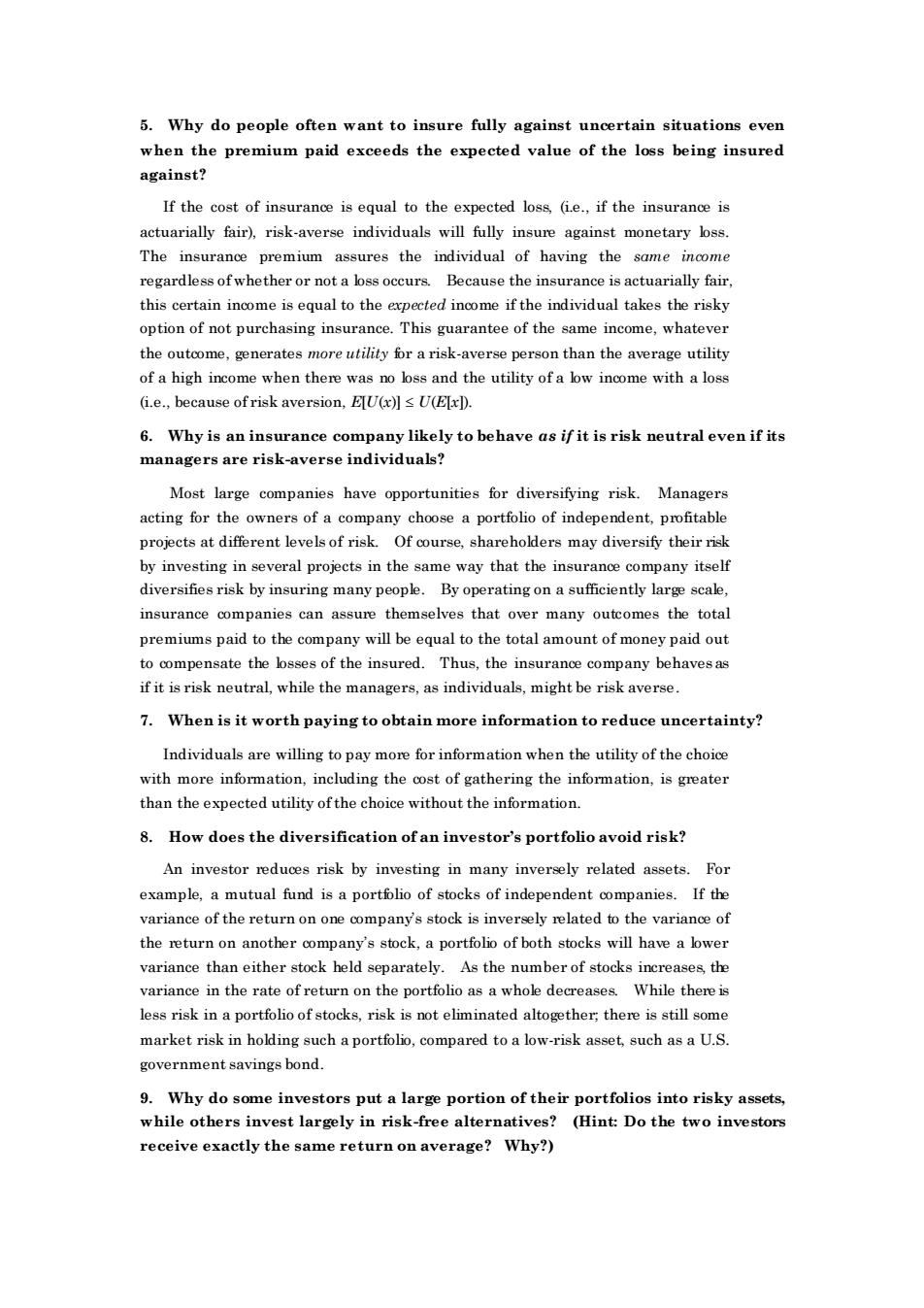正在加载图片...

5.Why do people often want to insure fully against uncertain situations even when the premium paid exceeds the expected value of the loss being insured against. If the cost of insurance is equal to the expected loss (ie.if the insurance is actuarially fair).risk-averse individuals will fully insure against monetary bss. The insurance premium assures the individual of having the same income regardless ofwhether or not a bss occurs Because the insurance is actuarially fair. option of not purchasing insurance.This guarantee of the same income,whateve the outcome,generates more utility for a risk-averse person than the average utility of a high income when there was no loss and the utility of a low income with a loss (ie.because ofrisk aversion.ElU(x)I s U(EIxD). 6.Why is an insu rance con pany likely to behave as ifit is risk neutral even if its nagers are risk-averse individuals? Most large companies have oppe tu nities for diversifying risk.Manage acting for the owners of a company choose a portfolio of independent,profitabl projects at different levels of risk.Of course,shareholders may diversify their risk by investing in several projects in the same way that the insurance company itself diversifies risk by insuring many people.By operating on a sufficiently large scale. insurance companies can assure themselves that over many outcomes the total premiums paid to the company will be equal to the e total amount of me ney paid ou to compensate the losses of the insured.Thus,the insurance company behaves as if it is risk neutral,while the managers,as individuals,might be risk averse. 7.When is it worth paying to obtain more information to reduce uncertainty? Individuals are willing to pay more for information when the utility of the choice with more information.including the cost of gathering the information,is greater than the expected utility ofthe choice without the information 8.How does the diversification of an investor's portfolio avoid risk? An investor reduces risk by investing in many inversely related assets.For example a mutual fund is a portlio of stocks of independent ompanies.If th variance of the return on one company's stock is inversely related to the variance of the return on another company's stock.a portfolio of both stocks will have a lower variance than either stock held separately.As the number of stocks increases the variance in the rate of return on the portfolio as a whole decreases While there is less risk in a portfolio of stocks,risk is not eliminated altogether there market risk in holding such a portfolio,compared to a low-risk asset,such as a U.S government savings bond. 9.Why do some investors put a large portion of their portfolios into risky assets, while others invest largely in risk-free alternatives?(Hint:Do the two investors receive exactly the same return on average?why?)5. Why do people often want to insure fully against uncertain situations even when the premium paid exceeds the expected value of the loss being insured against? If the cost of insurance is equal to the expected loss, (i.e., if the insurance is actuarially fair), risk-averse individuals will fully insure against monetary loss. The insurance premium assures the individual of having the same income regardless of whether or not a loss occurs. Because the insurance is actuarially fair, this certain income is equal to the expected income if the individual takes the risky option of not purchasing insurance. This guarantee of the same income, whatever the outcome, generates more utility for a risk-averse person than the average utility of a high income when there was no loss and the utility of a low income with a loss (i.e., because of risk aversion, E[U(x)] U(E[x]). 6. Why is an insurance company likely to behave as if it is risk neutral even if its managers are risk-averse individuals? Most large companies have opportunities for diversifying risk. Managers acting for the owners of a company choose a portfolio of independent, profitable projects at different levels of risk. Of course, shareholders may diversify their risk by investing in several projects in the same way that the insurance company itself diversifies risk by insuring many people. By operating on a sufficiently large scale, insurance companies can assure themselves that over many outcomes the total premiums paid to the company will be equal to the total amount of money paid out to compensate the losses of the insured. Thus, the insurance company behaves as if it is risk neutral, while the managers, as individuals, might be risk averse. 7. When is it worth paying to obtain more information to reduce uncertainty? Individuals are willing to pay more for information when the utility of the choice with more information, including the cost of gathering the information, is greater than the expected utility of the choice without the information. 8. How does the diversification of an investor’s portfolio avoid risk? An investor reduces risk by investing in many inversely related assets. For example, a mutual fund is a portfolio of stocks of independent companies. If the variance of the return on one company’s stock is inversely related to the variance of the return on another company’s stock, a portfolio of both stocks will have a lower variance than either stock held separately. As the number of stocks increases, the variance in the rate of return on the portfolio as a whole decreases. While there is less risk in a portfolio of stocks, risk is not eliminated altogether; there is still some market risk in holding such a portfolio, compared to a low-risk asset, such as a U.S. government savings bond. 9. Why do some investors put a large portion of their portfolios into risky assets, while others invest largely in risk-free alternatives? (Hint: Do the two investors receive exactly the same return on average? Why?)